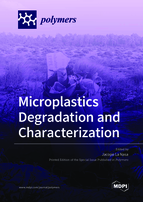Microplastics Degradation and Characterization
A special issue of Polymers (ISSN 2073-4360). This special issue belongs to the section "Circular and Green Polymer Science".
Deadline for manuscript submissions: closed (20 May 2022) | Viewed by 98731
Special Issue Editor
Interests: mass spectrometry; gas chromatography; liquid chromatography; analytical pyrolysis; natural organic materials; synthetic polymers; enviromental science; heritage science
Special Issue Information
Dear Colleagues,
In the last decade, issues related to pollution from microplastics in all environmental compartments, and the associated health and environmental risks, have been the focus of intense social, media, and political attention worldwide. The assessment, quantification, and study of degradation processes of plastic debris in the ecosystem and their interaction with biota have been and are still the focus of intense multidisciplinary research. Plastic particles in the range from 1 to 5 mm and those in the sub-micrometer range are commonly denoted as microplastics and nanoplastics, respectively. Microplastics are being recognized as nearly ubiquitous pollutants in water bodies, but their actual concentration, distribution, and effects on natural waters, sediments, and biota is still largely unknown. Contamination by microplastics of agricultural soil and other environmental compartments is also becoming a matter of concern.
This Special Issue is concerned with the latest developments in the study of microplastics (MPs). Topics may include new methodologies for sampling and/or separating MPs from complex environmental matrices; development of new approaches for the characterization and quantification of MPs; theory, simulation, and modeling of the degradation processes of MPs in the environment; study of the distribution at horizontal and vertical spatial scales of MPs in the environment; polymer-specific physical and chemical phenomena resulting in the formation of MPs; interaction of MPs with the biosphere; and removal of MPs from the environment. Both original contributions and reviews are welcome.
Dr. Jacopo La Nasa
Guest Editor
Manuscript Submission Information
Manuscripts should be submitted online at www.mdpi.com by registering and logging in to this website. Once you are registered, click here to go to the submission form. Manuscripts can be submitted until the deadline. All submissions that pass pre-check are peer-reviewed. Accepted papers will be published continuously in the journal (as soon as accepted) and will be listed together on the special issue website. Research articles, review articles as well as short communications are invited. For planned papers, a title and short abstract (about 100 words) can be sent to the Editorial Office for announcement on this website.
Submitted manuscripts should not have been published previously, nor be under consideration for publication elsewhere (except conference proceedings papers). All manuscripts are thoroughly refereed through a single-blind peer-review process. A guide for authors and other relevant information for submission of manuscripts is available on the Instructions for Authors page. Polymers is an international peer-reviewed open access semimonthly journal published by MDPI.
Please visit the Instructions for Authors page before submitting a manuscript. The Article Processing Charge (APC) for publication in this open access journal is 2700 CHF (Swiss Francs). Submitted papers should be well formatted and use good English. Authors may use MDPI's English editing service prior to publication or during author revisions.
Keywords
- Microplastics
- Polymer degradation
- Polymer characterization
- Environment
- Microplastics detection and identification (in complex matrices)
- Microplastics quantification
- Spectroscopy
- Chromatography
- Mass spectrometry
- Analytical pyrolysis







